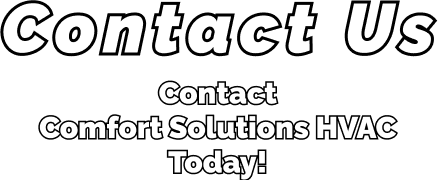Your HVAC Team in Easton, PA Explains
An odorless, tasteless, colorless gas, carbon monoxide (CO) often elicits fear and concern at the very mention of its name, and there is good reason for that. This deadly gas is harmful when inhaled by humans and pets. If you do not detect its presence in time, it can be potentially fatal. However, there are ways to prevent or arrest a carbon monoxide leak, before it poses a threat to your family’s health and wellbeing.
The HVAC specialists at Comfort Solutions HVAC throw light on CO and explain how your heating systems may be one of the biggest contributors to CO buildup.
Tips To Prevent and Combat Carbon Monoxide Buildup
According to the Centers for Disease Control and Prevention (CDC), over 400 Americans die from CO poisoning not linked to fires, while over 50,000 visit the emergency room due to accidental CO poisoning. Here are some things you should know about carbon monoxide:
- Where does CO come from? It is in the fumes produced each time you burn any fuel. This may be when you drive a vehicle, light a stove or lantern, or use a gas range, grill, fireplace, or furnace. If the gas gets trapped indoors, it can poison the people and animals who breathe it.
- What are the signs of a carbon monoxide leak? If you are breathing in carbon monoxide, you are likely to experience flu-like symptoms. This includes dizziness, headache, weakness, vomiting, chest pain, or even an upset stomach.
- Who is at risk of carbon monoxide poisoning? All humans and pets are vulnerable to CO’s deadly effects. However, children, the elderly, and people suffering from chronic heart or breathing problems are more likely to exhibit severe symptoms in the case of an undetected CO leak.
- What is the linkage between your furnace and CO poisoning? In an accurately installed furnace, carbon monoxide gas is vented outside your home. However, here are some reasons that could cause CO to build up and circulate indoors, posing a grave threat to the occupants of that space.
- Improper flue size
- Venting system blockages are caused by insects, bird or rodent nests, or seasonal debris.
- Cracks, corrosion, or damage in the heat exchanger impede its key functionality of venting poisonous gases away from heating ducts and outside the building.
What Can You Do to Prevent CO Poisoning?
- Schedule an annual maintenance service for your fireplace, furnace, water heater, and other fuel-burning appliances. Rely on qualified and experienced technicians and check the credentials of the agency or contractor you hire.
- Install a battery-operated or battery back-up CO detector in your home. Follow proper placement guidelines for your CO detectors and change the batteries every six months. CDC recommends replacing the detector every five years.
- Blocked chimneys are one of the main culprits for CO buildup. Get an inspection and chimney sweep done every year to keep them clean.
- Avoid using a portable generator, camp stove, charcoal grill, or other charcoal or gasoline-burning devices inside your home, garage, or near a window. Plug in your appliances through an extension cord to ensure that there is a distance of at least 20 feet from your doors, windows, or vents.
- Do not block, close, or patch a vent pipe by yourself. For any changes in venting, hire the services of licensed technicians.
How to Combat CO Poisoning
Despite all the precautions and timely servicing of your fuel-burning appliances, if the CO detector alarm goes off:
- Turn off your heating system and any other appliances that are in use
- Open the doors and windows to air out the space
- If any of the occupants show symptoms of CO poisoning, rush them to the emergency or call 911.
- Subsequently, hire a qualified technician to determine and fix the cause of the leak.
While installing carbon monoxide detectors may be a lifesaver, remember to take all necessary measures to prevent CO leaks. At Comfort Solutions HVAC, we advise clients to take advantage of our annual HVAC maintenance services and schedule an appointment during fall, before you switch over from air conditioning to heating. Our licensed and certified technicians will thoroughly inspect and fix any existing or potential issues before they turn into expensive or life-threatening problems.
Schedule a timely maintenance service for your heating system to enjoy a safe, energy-efficient winter. Call us at 610-477-2210 or contact us online for a free estimate.






